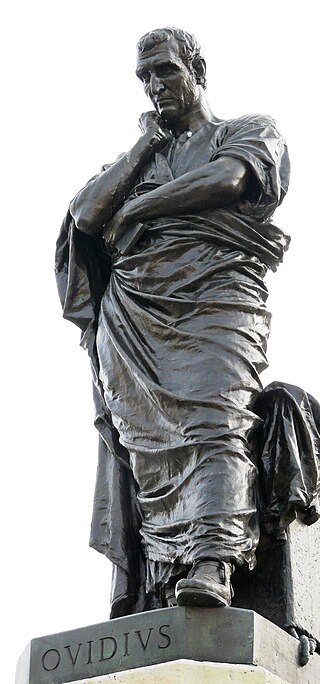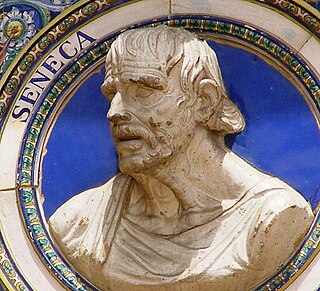
Rhetoric is the art of persuasion. It is one of the three ancient arts of discourse (trivium) along with grammar and logic/dialectic. As an academic discipline within the humanities, rhetoric aims to study the techniques that speakers or writers use to inform, persuade, and motivate their audiences. Rhetoric also provides heuristics for understanding, discovering, and developing arguments for particular situations.

Marcus Fabius Quintilianus was a Roman educator and rhetorician born in Hispania, widely referred to in medieval schools of rhetoric and in Renaissance writing. In English translation, he is usually referred to as Quintilian, although the alternate spellings of Quintillian and Quinctilian are occasionally seen, the latter in older texts.
Choricius of Gaza was a Gaza-based Greek sophist and rhetorician of Late Antiquity. With writings dating to the early sixth century, he flourished in the time of Anastasius I as a scholar and public orator. He is considered as part of the Rhetorical School of Gaza, of which he later became the chair.
Lucius Annaeus Seneca the Elder, also known as Seneca the Rhetorician, was a Roman writer, born of a wealthy equestrian family of Corduba, Hispania. He wrote a collection of reminiscences about the Roman schools of rhetoric, six books of which are extant in a more or less complete state and five others in epitome only. His principal work, a history of Roman affairs from the beginning of the Civil Wars until the last years of his life, is almost entirely lost to posterity. Seneca lived through the reigns of three significant emperors; Augustus, Tiberius and Caligula. He was the father of Lucius Junius Gallio Annaeanus, best known as a Proconsul of Achaia; his second son was the dramatist and Stoic philosopher Seneca the Younger (Lucius), who was tutor of Nero, and his third son, Marcus Annaeus Mela, became the father of the poet Lucan.
Gaius Valerius Flaccus was a 1st-century Roman poet who flourished during the "Silver Age" under the Flavian dynasty, and wrote a Latin Argonautica that owes a great deal to Apollonius of Rhodes' more famous epic.

The Second Sophistic is a literary-historical term referring to the Greek writers who flourished from the reign of Nero until c. 230 AD and who were catalogued and celebrated by Philostratus in his Lives of the Sophists. However, some recent research has indicated that this Second Sophistic, which was previously thought to have very suddenly and abruptly appeared in the late 1st century, actually had its roots in the early 1st century. It was followed in the 5th century by the philosophy of Byzantine rhetoric, sometimes referred to as the Third Sophistic.
Philodemus of Gadara was an Epicurean philosopher and poet. He studied under Zeno of Sidon in Athens, before moving to Rome, and then to Herculaneum. He was once known chiefly for his poetry preserved in the Greek Anthology, but since the 18th century, many writings of his have been discovered among the charred papyrus rolls at the Villa of the Papyri at Herculaneum. The task of excavating and deciphering these rolls is difficult, and work continues to this day. The works of Philodemus so far discovered include writings on ethics, theology, rhetoric, music, poetry, and the history of various philosophical schools. Ethel Ross Barker suggested in 1908 that he was owner of the Villa of the Papyri Library.

Education in ancient Rome progressed from an informal, familial system of education in the early Republic to a tuition-based system during the late Republic and the Empire. The Roman education system was based on the Greek system – and many of the private tutors in the Roman system were enslaved Greeks or freedmen. The educational methodology and curriculum used in Rome was copied in its provinces and provided a basis for education systems throughout later Western civilization. Organized education remained relatively rare, and there are few primary sources or accounts of the Roman educational process until the 2nd century AD. Due to the extensive power wielded by the pater familias over Roman families, the level and quality of education provided to Roman children varied drastically from family to family; nevertheless, Roman popular morality came eventually to expect fathers to have their children educated to some extent, and a complete advanced education was expected of any Roman who wished to enter politics.
Marcus Porcius Latro was a celebrated Roman rhetorician who is considered one of the founders of scholastic rhetoric.
The gens Arellia was a plebeian family at Rome. Although of equestrian rank, this gens does not appear to have been particularly large or important, and is known primarily from three individuals.
Jesuit drama was a form of theatre practised in the colleges of the Society of Jesus between the 16th and 18th centuries, as a way of instructing students in rhetoric, assimilating Christian values and imparting Catholic doctrine.
Papirius Fabianus was an Ancient Roman rhetorician and philosopher from the gens Papirius in the time of Tiberius and Caligula, in the first half of the 1st century AD.

Suasoria is an exercise in rhetoric: a form of declamation in which the student makes a speech which is the soliloquy of an historical figure debating how to proceed at a critical junction in his life. As an academic exercise, the speech is delivered as if in court against an adversary and was based on the Roman rhetorical doctrine and practice. The ancient Roman orator Quintilian said that suasoria may call upon a student to address an individual or groups such as the Senate, the citizens of Rome, Greeks or barbarians. The role-playing exercise developed the student's imagination as well as their logical and rhetorical skills.

A controversia is an exercise in rhetoric; a form of declamation in which the student speaks for one side in a notional legal case such as treason or poisoning. The facts of the matter and relevant law are presented in a persuasive manner, in the style of a legal counsel.
The gens Gargonia was a minor Roman family during first and second centuries BC. Some of the gens were of equestrian rank, but none appear to have held any curule magistracies.

The gens Nonia was a plebeian family at ancient Rome. Its members first appear in history toward the end of the Republic. The first of the Nonii to obtain the consulship was Lucius Nonius Asprenas in 36 BC. From then until the end of the fourth century, they regularly held the highest offices of the Roman state.

The gens Stertinia was a plebeian family of ancient Rome. It first rose to prominence at the time of the Second Punic War, and although none of its members attained the consulship in the time of the Republic, a number of Stertinii were so honoured in the course of the first two centuries of the Empire.

Gaius Furius Chresimus, or Cresimus, or Cressinus, was a 2nd-century BC Greek farmer and freedman in the Roman Republic mentioned in a fragment of the lost history of Lucius Calpurnius Piso Frugi, preserved in Pliny's Natural History. Piso tells that Furius Chresimus was acquitted of accusations of witchcraft during the aedileship of Spurius Postumius Albinus, dated 191 BC. The trial took place in a period of reaction against the growing influence of Hellenism at Rome, notably led by Albinus. Both Piso and Pliny told the story of the trial for its moralizing aspect.
Gaius Albucius Silus was an ancient Roman orator and teacher of rhetoric under emperor Augustus. He was born and died in Novaria, but made his career in Rome. Suetonius gives a sketch of his life, while Seneca the Elder describes him as an outstanding declaimer.
The gens Albinovana was an obscure plebeian family at ancient Rome. No members of this gens are known to have held any of the higher offices of the Roman state, and hardly any are mentioned in history. The family is perhaps best known from Publius Albinovanus, an infamous participant in the civil war between Marius and Sulla, and from the first-century poet Albinovanus Pedo. A number of Albinovani are known from inscriptions.








